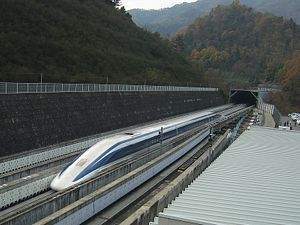The Central Japan Railway Co (JR Tokai) successfully completed another test run of its new ultra-high speed magnetic levitation (maglev) rail line on Monday, reaching a top speed of 500 km/hour, outstripping the fastest shinkansen train in operation, the Hayabusa, which tops out at 320 km/hour. The 42.8 km test track near Tsuru, Yamanashi prefecture provides just enough distance to reach the top range of the new “L-Zero” train system. The ambitious new line is set to connect Tokyo and Nagoya by 2027 in a trip that could be as short as 40 minutes.
According to a reporter for the Asahi Shimbun who participated in the test run, the train accelerates to 100 km/hour in just 26 seconds, and began “levitating” above the tracks moments later as it reached 350 km/hour in just 90 seconds. Despite the new record speeds, participants have so far said the ride was smooth, although when the train approached 400 km/hour it produced a sounds similar to what is experienced on an airplane. JR plans to reduce the noises experienced both inside and outside the train at high speed by installing a sound hood over portions of the guideway.
While the new train rollout is proceeding smoothly and generating interest domestically, the long-term plan is extremely costly and full of engineering challenges. The line is envisioned to connect Tokyo and Osaka by 2045 at an estimated construction cost of 9 trillion yen ($82 billion). Because of the direct route chosen by the rail company, 86 percent of the line will be enclosed in tunnels, with some stations in Shinagawa and Nagoya reaching 40 meters underground, meaning that estimated costs could surge after construction begins. Additionally, Reijiro Hashiyama at Chiba University of Commerce argues that the project is inherently risky in a country due to experience a rapid decline in population while airlines are increasing budget services. And if the project were to fail financially, Japanese taxpayers would likely be expected to foot the bill.
However, the new line does have several factors working in its favor. It is expected to be completed at a time when the parallel shinkansen track is due for a major overhaul, meaning it may not have to compete with another established high-speed option. Additionally, the ticket price for a trip between Tokyo and Osaka is only expected to increase 1,000 yen ($9.20), while the travel time would be cut in half to 67 minutes. The new train could meet other needs besides decreasing time and cost of traveling. Driverless trains could be beneficial in a country with a shrinking labor market, especially if other services are automated, which would further drive down costs. JR Central is also conducting two more exhibitions in November and December. Public displays of the technological and engineering feats required to comfortably travel at such high speeds while underground will be helpful in attracting international customers, particularly those in Southeast Asia with plans to begin awarding contracts for high-speed rail in the next few years.

































